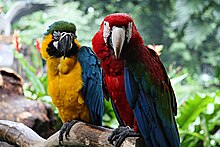Ara (genus)
| Ara | |
|---|---|
 |
|
| Blue-and-yellow macaw (left) and green-winged macaw (right) at Jurong Bird Park, Singapore | |
| Scientific classification | |
| Kingdom: | Animalia |
| Phylum: | Chordata |
| Class: | Aves |
| Order: | Psittaciformes |
| Superfamily: | Psittacoidea |
| Family: | Psittacidae |
| Subfamily: | Arinae |
| Tribe: | Arini |
| Genus: |
Ara Lacépède, 1799 |
| species | |
|
see text |
|
see text
Ara is a neotropical genus of macaws with eight extant species and at least two extinct species. The genus name was coined by French naturalist Bernard Germain de Lacépède in 1799. It gives its name to and is part of the Arini, or tribe of neotropical parrots. The genus name Ara is likely related to arara, the Portuguese word for a macaw, itself derived from the Tupi word a'rara.
The Ara macaws are large striking parrots with long tails, long narrow wings and vividly coloured plumage. They all have a characteristic bare face patch around the eyes. Males and females have similar plumage. Many of its members are popular in the pet trade, and bird smuggling is a threat to several species.
For many years the genus Ara contained a number of other species. Three genera have been split out from the genus, Orthopsittaca, Primolius, and Diopsittaca. Orthopsittaca and Diopsittaca are two monotypic genera that were morphologically and behaviourally different, whereas the three Primolius macaws are three smaller green macaws.
There are eight surviving species and two extinct species. The last confirmed sighting of the extinct Cuban red macaw was in 1864 when one was shot. Several skins of the Cuban red macaw are preserved in museums, but none of its eggs have survived.
The Ara genus is subdivided as follows:
Several hypothetical extinct species of the Ara genus have been postulated based on very little evidence. They may have been distinct species, or familiar parrots that were imported onto an island and later presumed to have a separate identity.
The Ara macaws are large parrots ranging from 46–51 cm (18–20 in) in length and 285 to 287 g (10 oz) in weight in the chestnut-fronted macaw to 90–95 cm (35.5–37.5 in) 1,708 g (60.2 oz) in the green-winged macaw. The wings of these macaws are long and narrow which is typical for species of parrot which travel long distances in order to forage. They have a massive downward curved upper mandible and a patch of pale skin around the eye that extends to base of the beak. The skin patch bears minute feathers arranged in lines that form a pattern over the otherwise bare skin in all species of the genus except the scarlet macaw in which the skin is bare. In most species the bill is black, but the scarlet macaw and green-winged macaw have a predominantly horn coloured upper mandible and a black lower one.
...
Wikipedia
